
Sea Surgeon's Dispensatory: 1 2 3 4 5 6 7 8 9 10 11 12 13 14 15 16 17 18 19 20 21 22 23 24 25 Next>>
The Sea Surgeon's Dispensatory, Page 14
Part 1: Simples
Simple medicines or 'simples' are those that are in their simple, natural state. They include plants and their individual parts, animals and their parts and minerals.
Simples: Plants
This section includes all the plant-based medicinal materials which are used without chemical processing such as roots, flowers, leaves, stems, juices and gums.
Absinthii (Wormwood)
Listed in: Woodall: Absynthium1, Moyle: Absynthis2, Tweedy: Absinth.3
Category: Simple - Plant
Humoral Property: hot & dry in the 3rd degree4; hot & dry in the 2nd or 3rd degree5; "hot in the first degree and drie in the third"6
Photo: H. Zell - Absinthi Artemisia Absinthium
Description: "Absynthium or Wormewood ...is bitter, sharpe, and astringent [contract the body's tissues], clensing, purging, and comforting, excellent to purge the stomake, liver, and reines [kidneys], from chollericke humours, and to stay the weake stomake from vomiting, cureth the jandice, resisteth pestilent infection, helpeth the dropsie [swelling of soft tissues], and spleneticke [bad temper, thought to originate in the splene], and killeth wormes in the body."7
"It has been in great esteem not only as a Stomachick, upon the account of its Bitterness, and also for the same reason a Destroyer of Worms, but as great a Detergent; and therefore prescribed in the Jaundice, and even in Dropsies. But its use in such Intentions is now quite laid aside, and it is little regarded as a Stomachick [medicine to improve the stomach and increase appetite]; … This Herb is in some of the Shop-Compositions [compound medicines], and a good Ingredient enough in cephalick distill’d Waters [waters to treat problems of the head], where its volatile Particles rise and contribute to their medicinal Efficacies; its pungent and almost caustick Salt, so hurtful to the Nerves of some dry Contitutions, remaining behind. For which very reason likewise it is used in some external Intentions, in Fomentation; the saline Parts remaining in the Decoction, being very serveable to stimulate and discuss [disperse] some particular Tumours."8
1 John Woodall, the surgions mate, 1617, p. 120; 2 John Moyle, The Sea Chirurgeon, 1693, p. 32; 3 "158. John Tweedy’s Bill for Medicines. November 8, 1743". Privateering and Piracy in the Colonial Period Illustrative Documents, John Franklin Jameson, ed., p. 459; 4 Thomas Brugis, The Marrow of Physick, 1669, p. 146; 5 Nicholas Culpeper, Pharmacopœia Londinesis, p. 17; 6,7 Woodall, p. 120; 8 John Quincy, Pharmacopoeia Officinalis & Extemporanea, 1719, p. 127
Agaricum (Agaricum Mushroom)
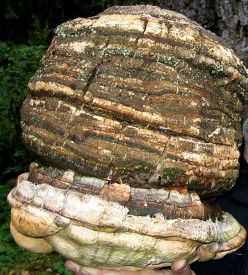
Photo: Dusty Yao Stamets
Agarickon Laricifomes Officinalis
Listed in: Woodall Chest: Agaricum1, Moyle: Agaric2
Category: Simple - Plant
Humoral Property: hot in the first degree, dry in the second3; "hot in the first degree, and drie in the second"4
Description: "Agaricum or Agaricke ... purgeth phleame [phlegm - a humor], freeth from obstructions, attenuateth [reduces force], clenseth, & dissipateth winde, and helpeth all diseases which spring from grosse, cold, and raw humors: the dose is {1 dram}. But beware of the use thereof in the curing any fluxes of the belly."5
"Fungus Agarici, Agarick. This is a Fungus, or Mushroom, growing on the Larch-Tree, that produces the Venice Turpentine. That is accounted best which is light, spongy, and white; tho the best rather makes People sick, than purges them, for it is extremely nauseous to the Stomach, and without the help of other Purgers, is not strong enough to work of it self. "6
1 John Woodall, the surgions mate, 1617, p. 94; 2 John Moyle, The Sea Chirurgeon, 1693, p. 33; 3 Jean de Renou, A Medicinal Dispensatory, 1657, p. 259; 4,5 Woodall, p. 94; 6 John Quincy, The Dispensatory of the Royal College of Physicians in London, 1719, p. 181
Aloes
Listed in: Woodall Chest: Aloes cicotrine1
Category: Simple - Plant
Humoral Property: hot in the first degree, dry in the third2; "the best is hot in the second, and drie in the third degree"3
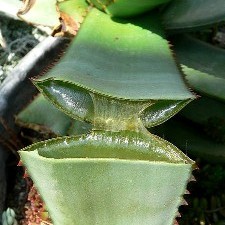
Photo: Wiki User Raul654 - Aloe
Plant
Description:"Aloes ... removeth cold, phlegmaticke [phlegm], and cholericke [yellow bile] humors by purging, digesting, and dryving them out, it is a soveraigne [supreme or ultimate] medicine for the stomacke."4
Nicholas Culpeper agrees with Aloes' ability to drive out humors, explaining that it does so "with such deliberation, that it is often given to withstand the violence of other Purges, it preserves the Senses, and better the apprehension; it strengthens the Liver, and helps the yellow Jaundice. Yet is naught for such as are troubled with the Hemorrhoids, or have Agues. I do not like it taken raw."5
According to John Pechey, they can be gotten "from the Island Succotra in India. This sort is the best of all; 'tis transparent, and colour'd somewhat like the Liver."6 John Quincy agrees. "It is a Tree in the East-Indies, brought to us in small bits of a very fragrant Scent. The best is accounted of a blackish purple Colour, and so light as to swim upon Water."7
Modern effectiveness: Clinical research suggests that topical use of aloe gel can improve acne, help with herpes simplex, lichen planus and psoriasis and speed up burn healing. Oral doses of aloe leaf extract may help irritable bowel syndrome (although some studies suggest it does not) and ulcerative colitus. Note that this is not medical advice and the author is not a medical professional. Some people have experienced itching from topical aloe application. Taken internally, aloe leaf extract may cause gastrointestinal cancer in rats. Overuse can cause adverse effects for those taking digoxen. It is not recommended for use by pregnant women.8
1 John Woodall, the surgions mate, 1617, p. 94; 2 Jean de Renou, A Medicinal Dispensatory, 1657, p. 256; 3,4 Woodall, p. 94; 5 Nicholas Culpeper, A Pharmacopoeia Londeniis, p. 45; 6 John Pechey, The Compleat Herbal of Physical Plants, 1707, p. 202; 7 John Quincy, The Dispensatory of the Royal College of Physicians in London, 1719, p. 85; 8 Stephen Foster, "Aloe Vera", www.nccih.nih.gov, gathered 2/17/23
Amygdalarum Amaræ (Bitter Almonds)
Listed in: Woodall: Amigdalæ dulces1
Category: Simple - Plant
Photo: Abu Shawka - Bitter Almond Tree (Brabejum stellatifolium)
Humoral Property: hot and dry2, "hot in the first degree, dry in the second"3
Description: "Amigdalæ amaræ, bitter Almonds... are abstersive [purging] more then sweet ones: they doe open and purge the lungs, liver, spleene, kidnies, urinall passages, reynes [kidneys or lower back], & bowels; and are good against spitting of blood.”4
"The Almond-tree. They grow spontaneously in the warmer Climates, as Spain, Barbary, Italy, and France; they flower early in the Spring, and the Fruit is ripe in August. ...Bitter Almonds, prove mortal to many Animals, Quadrapeds, and Birds. In Storks, Doves, Cats, and Dogs, they excite Convulsions... But to Mankind they afford a proper Medicine on many Occasions, tho' they are rarely eaten on Account of their Bitterness. They are of a stimulating detergent, aperient [laxative], and diuretic Quality."5
1 John Woodall, the surgions mate, 1617, p. 102; 2 Nicholas Culpeper, Pharmacopœia Londinesis, p. 45; 3,4 Woodall, p. 102;5 Robert James, Pharmacopœia universalis, 1707, p. 226;
Amygdalarum Dulcium (Sweet Almonds)
Listed in: Woodall: Amigdalæ dulces1
Category: Simple - Plant
Humoral Property: pretty temperate2, "hot and moist in the first degree"3
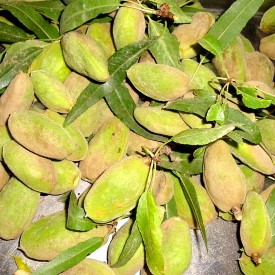
Photo: Ahmed-Najib Biabani Ibrahimkhel
Almonds
Description: "Amigdalæ dulces or sweet Almonds, ...doe extenuate, purge, and clense the bowels: draw spittle from the breast, and lungs: are good for the moist, and dry stomacke: cleareth the skin from spots, pimples, and lentils: stop spitting of bloud, and ingender choller [cholar - yellow bile - one of the four bodily humors].”4
"Almond-tree, in Latin Amygdalus. There are many sorts of Almonds; but in Practice they are distinguish'd only in Bitter and Sweet. The Jordan-Almonds are most esteem'd amongst us; which are larger, longer and narrower, rounder and thicker, than the Valenian; and of a better Taste. Sweet Almonds nourish much, and make the Body fat. The mitigate the Acrimony of the Humours, and increase Seed. They are good for Lean People, and for such as are Consumptive [those with tuberculosis]. But they are chiefly used in Emulsions."5 "They grow in Germany, Italy, and France."6
1 John Woodall, the surgions mate, 1617, p. 102; 2 Jean de Renou, A Medicinal Dispensatory, 1657, p. 387; 3,4 Woodall, p. 102;5 John Pechey, The Compleat Herbal of Physical Plants, 1707, p. 200; 6 Pechey, p. 202
Amylum (White Starch)
Listed in: Woodall: Amylum1
Category: Simple - Plant
Humoral Property: moderately hot2; "moderately hot"3
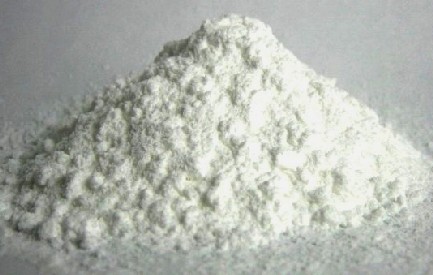
Wheat Starch
Description: "Amylum, or white starch ...levigateth [smooths] the parts exasperated: it is effectuall against the defluxions of humors into the eyes: against pustles and hollow ulcers: it filleth with flesh: stoppeth spitting of blood: helpeth the roughnes, and soreness of the breast, and throat: and easeth the cough. And is very good in the fluxes of the belly to be given in glisters [clysters - enemas] against inflammations and excoriations in the intrails."4
"Prepared from wheat flour, by washing it in running water, by means of sacks, to separate the gluten which remains in the sacks, while the starch is washed away and received in troughs, where, by fermentation, it is freed from saccharine and extractive matter, and is left in a very pure state.
...
Medicinally starch is a useful demulcent [relieves inflammation] in forms of enema, in diarrhœa, dysentery, tensemus [a feeling of needing to pass stool when the colon is empty], and disorders of the rectum."5
1 John Woodall, the surgions mate, 1617, p. 103;2 Thomas Brugis, The Marrow of Physick, 1669, p. 162; 3,4 Woodall, p. 103; 5 James Rennie, A New Supplement to the Pharmacopœpias of London, Edinburgh, Dublin and Paris, Baldwin and Cradock, 1833, p. 263;
Baccæ Lauri (Bayberry Fruit)
Listed in: Woodall: Baccæ Lauri1, Moyle: Bacc. Lauri2
Category: Simple - Plant
Humoral Property: hot in the third degree & dry in second3; "hot and drie in the second degree"4
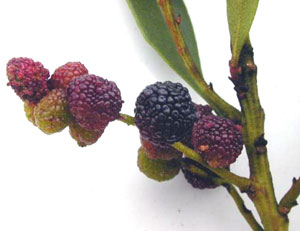
Bayberry Fruit - Myrica Faya
Description: "Baccæ lauri or Bay berries ...resist poison, helpe deafnesse, contracted and wearied parts, and the paine of the breast, cut up fleame [phlegm - one of the bodily humors], and take away scrurfe [dry flaking of the skin, such as dandruff]."5
"Bay-tree, in Latin Laurus. A Decoction of the Bark, Berries and leaves make a good Bath for the Diseases of the Womb and Bladder. The Berries are very effectual against all Poisons of venemous Creatures, and the stingings of Wasps and Bees, and also in the Plague, and infectious Diseases; and therefore are an Ingredient in the London-Treacle. They procure the Courses [a woman's period]: and 'tis said that seven of the Berries taken inwardly, will hasten Delivery, and expel the After-Birth. Being made into an Electuary with Hony, they cure old Coughs, and Shortness of Breath, and stop Rheums [eye and nasal flows]: they expel Wind, and provoke Urine, and comfort the Stomach. The Oyl which is made of the Berries is very useful in cold Diseases of the Joints and Nerves."6
1 John Woodall, the surgions mate, 1617, p. 117; 2 John Moyle, The Sea Chirurgeon, 1693, p. 33; 3 Thomas Brugis, The Marrow of Physick, 1669, p. 159; 3,4 Woodall, p. 117; 6 John Pechey, The Compleat Herbal of Physical Plants, 1707, p. 17
Baceæ Juniperi (Juniper Berries)
Listed in: Woodall: Baceæ Juniperi1, Moyle: Bacc. Juniperi 2, Tweedy: Bacc. Juniper.3
Category: Simple - Plant
Humoral Property: hot in the third, dry in the second degree4; hot [calefy]5; "hot in the third degree, drie in the first"6
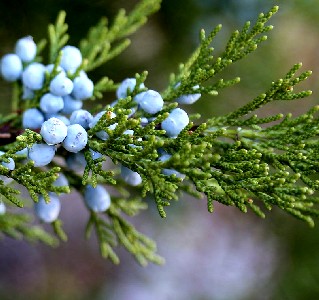
Photo: (Wiki) Dcrjsr - Juniper Berries - Juniperus Occidentalis
Description: "Juniper berries are ...astringent [contract the body's tissues], are good for the stomake, cough, windinesse, gripings of the belly, venomous bitings, infection, contagion of the aire, helpe the lungs, liver, kidnies, and bladder, and provoke urine."7
"Juniper-Berries. ... All the Parts of this Tree are of a balsamick nature... the glutinous and adhesive Properties of their Juices preserving them from those Decays other Vegetables are subject to in the Winter. ...The Berries are suppos'd to contain the Virtues of the whole, and are very much used for many medicinal Purposes. Some will have them to be great Strengthners of the Stomach, and effectual against Malignities and Epidemical Infections. ...They are certainly carminative [prevent gas formation], and very much contribute to dissipate Wind, and Flatulencies in the Stomach and Bowels. But their most celebrated and remarkable Properties, are, in deterging and scouring the Viscera [internal organs], and particularly the Reins [kidneys] and Urinary Passages, as all indeed of the Turpentine kind do. ...some rely upon them in Gonorrhœa's and Venereal Ulcerations and Erosions of the genital Parts."8
1 John Woodall, the surgions mate, 1617, p. 117; 2 John Moyle, The Sea Chirurgeon, 1693, p. 33; 3"158. John Tweedy's Bill for Medicines. November 8, 1743". Privateering and Piracy in the Colonial Period Illustrative Documents, John Franklin Jameson, ed., p. 460; 4 Thomas Brugis, The Marrow of Physick, 1669, p. 159; 5 Jean de Renou, A Medicinal Dispensatory, 1657, p. 391; 6,7 Woodall, p. 117; 8 John Quincy, Pharmacopoeia Officinalis & Extemporanea, 1719, p. 135
Balsamum Capivi (Balsam of Capivi)
Listed in:Tweedy:Bals. Copivi.1
Category: Simple - Plants
Photo: Mauro Halpern - Copaifera Landsdorfii
Description: "This is obtain'd by making an Incision in a Tree thus distinguish'd.... The white American Balsam Tree. [This rather vague name does not positively identify the plant used to obtain this balsam, probably because the author was not familiar with it. The trees from which this balsam is obtained belongs to the Copaifera family.2] The Balsam of Capivi is produc'd in Brasil, and brought to us from Rio de Jaineiro, Fernambouc [Pernambouco, Brazil], and St. Vincent in earthen Vessels. There are two Sorts of it, the one very limpid [clear] and the other pretty thick, and of the Consistence of Turpentine; but this Difference depends upon the different Seasons of gathering it. The limpid Kind... is most esteem'd both for internal and external Purposes; for when dissolved in Tincture of Tartar, it is successfully exhibited for a Flour albus [vaginal discharge], Gonorrhæas, and Disorders of the Kidneys and Bladder. Externally it is an excellent Liniment for the Consolidation of Wounds and Ulcers, and for corroborating [strengthening] the nervous Parts, which have been weakened by the Shock of any Disease."3
"This Balsam is not taken notice of but by very late Winters, especially under this name [Capivi]. It is of a thinner Consistence than the common Turpentine, but much more fragrant and detersive. It is extremely quick in passing off by Urine, and mightily cleanses those Passages by which it has obtain'd very much in Gonorrhea's, and all Obstructions and Ulcerations of those Parts. It is likewise a powerful Balsamick [having restorative and curative properties], and good in many Distempers of the Breast. The Yolk of an Egg will mix it in any liquid Form."4
1 "158. John Tweedy's Bill for Medicines. November 8, 1743". Privateering and Piracy in the Colonial Period Illustrative Documents, John Franklin Jameson, ed., p. 457; 2 "Copaiba," wikipedia.org, gathered 7/24/15; 3 Robert James, Pharmacopoeia Universalis, 1747, p. 248;4 John Quincy, Pharmacopoeia Officinalis & Extemporanea, 1719, p. 136
Balsamum Pervianum (Balsam of Peru)
Listed in: Tweedy: Bals. Peru.1
Category: Simple - Plants
Humoral Property: dries2, warm3
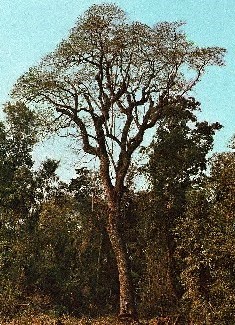
Photo: Jorge Vallmitjana - Myroxylon Peruiferum
Description: "This is produced from a Tree in the West-Indies [Myroxylon4]. By boiling the Wood, the Balsam rises to the top, which is scummed off for use. The best is of a darkish red Colour, and of an admirable Fragrancy. It heals, dries, and discusses [disperses], and is a great Strengthner and Warmer of the Nerves. ...It is much used outwardly, not only in Wounds, but in Palsies, Ischiadick [sciatica of the hip joint] and Rheumatick Pains. Some pretend to cure intermitting Fevers by rubbing the Back-bone with it, and applying it in Plasters to the Pit of the Stomach."5
Physician Robert James identifies two types of Pervian Balsam - white and black. He advises his readers that "the white is accounted best... it flows spontaneously from a Tree of large Size, upon making an incision in it. This Species is limpid [clear], of the Consistence of Turpentine, of a fragrant Smell, and much scarcer and dearer than the black Sort; but it is often adulterated with Venice Turpentine. The black Sort, of which large Quanities are imorted to us, is... prepared by boiling the Branches, Bark, and Leaves of the Tree. But this species is also often adulterated, probably with liquid Storax. ... The black Peruvian Balsam, according to [French physician Stephen Francis] Geoffroy, is of a warming and strengthening Nature, comforting the Brain and nervous System; proves beneficial in Asthmas, the Colic, and Pains of the Stomach and Intestines. Externally used it corroborates [strenthens] the Nerves, alleviates the Cramp, relieves all Kinds of Convulsions, and Contractions of the Sinews, old Achs and Pains. It is, also, serviceable in Cuts and green [fresh] Wounds."6
1 "158. John Tweedy's Bill for Medicines. November 8, 1743". Privateering and Piracy in the Colonial Period Illustrative Documents, John Franklin Jameson, ed., p. 457; 2 John Quincy, Pharmacopoeia Officinalis & Extemporanea, 1719, p. 84; 3 Robert James, Pharmacopoeia Universalis, 1747, p. 249; 4 "Balsam of Peru," wikipedia.org, gathered 7/24/15; 5 Quincy, p. 84-5; 6 James, p. 249
Bdellium
Listed in: Woodall: Of Bdellium1
Category: Simple - Plant
Humoral Property: heats2; hot [callifies]3; "warm"4
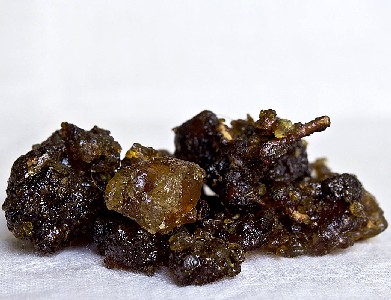
Photo: Wiki User Jacopo188 - Bdellium Resin
Description: "Bdellium doth ...mollifie [soften] hard tumours in the throat, and discusseth [disperses] Hermaes [hernias] in their beginnings: provoketh urine, and is good against the cough.”5
"This flows from a thorny Shrub in Arabia and the Indies [Commiphora wightii and from Commiphora africana trees]. It is somewhat Bitterish to the Taste, looks tra[ns]lucent when broke, and if rubbed seems of a fattish Substance. ...It is reckon'd to facilitate Digestion, to discuss [disperse], and promote Perspiration; and to be good in Coughs, and many Disorders of the Breast. But its chief use now in Composition [compound medicines], is in Discutient [matter dispersing] Plasters; in which it is mightily commended for reducing of Ruptures, and softening any Indurations [hardened areas] of the nervous Parts."6
1 John Woodall, the surgions mate, 1617, p. 105; 2 Nicholas Culpeper, Pharmacopœia Londinesis, p. 46; 3 Jean de Renou, A Medicinal Dispensatory, 1657, p. 388; 4,5 Woodall, p. 105; 6 John Quincy, Pharmacopoeia Officinalis & Extemporanea, 1719, p. 119
Benzoinum (Benjamin or Benzoin)
Listed in: Woodall: Belzoin1
Category: Simple - Plant
Humoral Property: hot and dry in the 1st degree2; "hot in the fourth degree"3
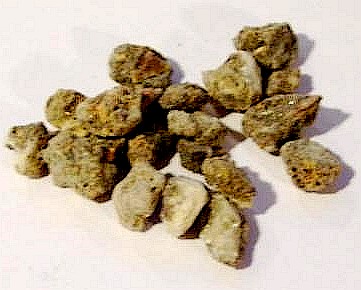
Photo: Birgit Lachner - Styrax Benzoin (Benjamin Resin)
Description: "Belzoin, called vulgarly Benjamen...comforteth the heart, and all the faculties thereof, and hath the same power as Styrax Calamita aforesayd [Storax calamintha – liquidambar resin which does "mollifie [soften], concoct, cure the cough, distillations, hoarsenes, pose or stuffing of the head, matrix [womb] stopped: are good to procure the monethly courses [periods] of women, cordiall [good for the heart], exhilarating: opposite to poyson, and doe discusse [dissipate] hard cold tumors, the knots of the sinewes, and the struma [swollen thyroid in the neck]."4, the reddish, cleare, full of white drops like frankincense, and of a sweet smell as Xiloaloes [aloe bark] burned, is chosen.”5
"It attenuates: 'Tis hot and dry. 'Tis used for Coughs, Rheums [watery fluid discharging from the nose and eyes], and Obstructions of the Lungs. It comes from Sumatra, Surat and several other Places. ...The Flowers are good for Asthmatical Persons, and to fortifie the Stomach. The Dose is, from two Grains to five, in an Egg, or in Lozenges. The Oyl is a Balsam for Wounds and Ulcers."6
1 John Woodall, the surgions mate, 1617, p. 107; 2 Jean de Renou, A Medicinal Dispensatory, 1657, p. 275; 3 Woodall, p. 107; 4 Woodall, p. 106-7; 5 Woodall, p. 107; 6 John Pechey, The Compleat Herbal of Physical Plants, 1707, p. 219
Camphora
Listed in: Woodall-Chest: Camphoria1
Category: Simple - Plant
Humoral Property: cold & dry in the 3rd degree2; "good in both hot and cold diseases"3; "of a mixt quality, refrigerateth [cools] and calefieth [warms]"4
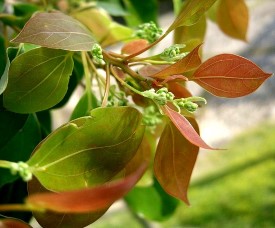
Photo: Wiki User Kenpei
Cinnamomum Camphora - Producer of Camphor
Description: "Camphuræ or Camphora ...asswageth the paine of the head, inflammations of ulcers, wounds, cureth Erysipelas or St. Anthonies fire [severe redness and swelling of the skin], is effectuall against the Gohorrhea, the white flowers of women [white discharge from the vagina], bleeding of the nose, it is good against venoms and poysons: it preserveth the body from putrefaction [decomposition], and is commended for many other vertues for brevity omitted."5
"Camphora. Camphire. This is not mentioned by the ancient Greeks, and was first introduced into the Materia Medica by the Arabians. It is a Substance of a very singular Nature, dry, friable [easily crumbled], powder'd with Difficulty, light, white, pellucid [clear], and not unlike the Crystals of Salt, of an acrid and somewhat bitterish Taste, of a penetrating Smell, and to some greatly offensive. It flames in an open Fire, and when kindled, burns till it is totally consumed; in Water it also, burns, and sends forth a thick dark Smoak, which also produces a blackish Soot."6
"It destils, Drop by Drop, from a great Tree, much like a Walnut-tree, in the Island Bornco, in Asia. Little Cakes of it are likewise brought out of China, but that is not so good."7
1 John Woodall, the surgions mate, 1617, p. 110; 2 Nicholas Culpeper, Pharmacopœia Londinesis, 1720, p. 74; 3 Jean de Renou, A Medicinal Dispensatory, 1657, p. 385; 4,5 Woodall, p. 110; 6 Robert James, Pharmacopoeia Universalis, 1747, p. 270; 7 John Pechey, The Compleat Herbal of Physical Plants, 1707, p. 229
Cardui Benedicti (Blessed Thistle)
Listed in: Woodall: Cardum benedictus1
Category: Simple - Plant
Humoral Property: hot and dry in the second degree2, hot & dry in the second3, heats ["calefies"]4, "hot"5
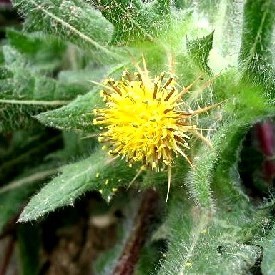
Cardui Benedicti - Blessed Thistle
Description: "Carduns benedictus or the blessed Thistell is very bitter, and hot, comforteth the heart and vitall parts, moveth sweate, resisteth poyson, is of much use in pestilent diseases, mittigateth the paine of the reines [lower back & kidneys], and sides, killeth the wormes of the belly, and prevaileth against biting of Serpents.”6
“It flowers in June and July. [17th c. German Physician and Pharamacologist Johann] Schroder observes somewhat very odd, that if it be gather’d in the middle or beginning of June, it is very efficacious in curing fresh Wounds, but that it has no such Virtue if gather’d at any other time. A strong Decoction of this Herb will [cause a] vomit, and it is often used to that very purpose; but in composition with other Stomachicks [medicines good for the stomach and increasing appetite], and drank not in too large quantities, it has no such effect, and is a very good Ingredient. It is also accounted Cardiack [good for the heart] and Alexipharmick [good for curing poisoning], and enters into many Compositions of the Shops of those Intentions. Some have prescribed it in the form of Syrups, Conserves, and many of the like kind; but such are quite now out of use. It enters also into many Fomentations, as a good Discutient [disperser of morbid matter].”7
1 John Woodall, the surgions mate, 1617, p. 120;2 Thomas Brugis, The Marrow of Physick, 1669, p. 147; 3 Nicholas Culpeper, Pharmacopœia Londinesis, 1720, p. 23; 3 Jean de Renou, A Medicinal Dispensatory, 1657, p. 332; 5,6 Woodall, p. 120; 8 John Quincy, Pharmacopoeia Officinalis & Extemporanea, 1719, p. 109;
Caryophyllus Aromaticus (Cloves)
Listed in: Woodall: Cariophill1
Category: Simple - Plant
Humoral Property: hot and dry in the second degree2; "Cloves heat and dry."3; "hot and dry in the second degree"4
Photo: Wiki User Miansari66 - Whole Cloves
Description: "Cariophilli, or Cloves ...are Aromaticall, and beneficiall to the heart, and braine: helpeth the liver, and stomacke: maketh the breath sweet: are good for digestion: quickeneth the sight: stirreth up lust, and taketh away obstructions.”5
"Cloves, in Latin Caryophyllus Aromaticus. ...The Indians, two Days before they sell their Cloves, place a large Vessel of Water in the Room where the Cloves are; and it all soon evaporates, and goes into the Cloves; and so the weight of them is much increas'd. Cloves perfume the Breath; for which Reason the Indian Women frequently chew them, and such like things. They are said to clear the Sight, and to take off Clouds from the Eyes. The strengthen the Stomach and take off Vomiting and Nauseousness. They provoke Venery [sexual desire], and are good for all cold Diseases of the Brain; as, Apoplexies [unconsciousness, often caused by a stroke], Lethargies, Palsie, or the like. They are used to correct the Air, by being burnt or eaten."6
1 John Woodall, the surgions mate, 1617, p. 104; 2 Jean de Renou, A Medicinal Dispensatory, 1657, p. 280; 3 John Pechey, The Compleat Herbal of Physical Plants, 1707, p. 244; 4,5 Woodall, p. 104; 8 John Quincy, Pharmacopoeia Officinalis & Extemporanea, 1719, p. 127; 6 Pechey, p. 244
Cassia Fistula
Listed in: Woodall: Cassia fistula1
Category: Simple - Plant
Humoral Property: temperate2; "hot, and moist in the first degree"3
_fruits_J_M_Garg.jpg)
Photo: J.M. Garg - Cassia Fistula (Amaltas) Pods
Description: "Cassia fistula ...tempereth immoderate heate, purgeth gently chollericke [choler - yellow bile] humors, and is good for the reines [lower back and kidneys], and kidnies, driving foorth gravell, and the [kidney] stone.”4
“Cassia Fistula, is temperate in quality, gently purgeth Choler and phlegm [two of the bodily humors], clarifies the blood, resists Fevers, cleanseth the Breast and Lungs, it cools the Reins [kidneys], and thereby resisteth the breeding of the stone. It provokes Urine, and therefore is exceeding good for the running of the Reins, in men, and the Whites [discharge from the vagina] in Women.”5
“The Quintessence [truest essence] of Cassia fistula is put in a sieve made of horses haire, theat the pith alone is purged from the broken huskes and seeds may be extracted, which is called extract of Cassia."6
1 John Woodall, the surgions mate, 1617, p. 97; 2 Nicholas Culpeper, Pharmacopœia Londinesis, 1720, p. 42; 3,4 Woodall, p. 97; 5 Culpeper, p. 42; 6 Jean de Renou, A Medicinal Dispensatory, 1657, p. 81
Centaurii Minoris (Lesser Centaury)
Listed in: Tweedy: Centaur. Minor.1
Category: Simple - Plant
Humoral Property: hot and dry in the 1st degree2; heats [calefies] potently3
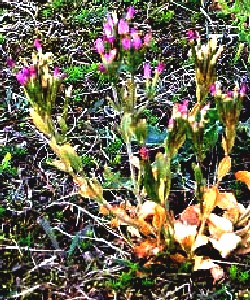
Photo: Evelyn Simak- Lesser Centaury
Description: "It flowers in July, and is common in dry Pastures. …‘Tis Splenetick [good for treating the splene] and Hepatic [good for treating the liver], bitter without Biting: ‘tis Cleansing, Opening and Vulnerary [used to heal wounds]: ‘Tis good in the Jaundice, in Suppression of the Courses [women's periods], in the Gout, and for the Worms; and is a Specifick for the Biting of the Mad-Dog. The Decoction of it is us’d with Success in the Tertian-Agues [fevers occurring every three days, usually caused by malaria]; wherefore ‘tis called by some the Febrifuge-Plant.”4
"Cantaurii Minoris, the Lesser Centaury. This flowers in July and August. It is an excellent Bitter, and very serviceable to the Stomach in all Compositions of that kind; and is good by it self in Decoction or Infusion, which best Made in Wine, or small Gentian Water. It wonderfully discusses [disperses] and absterges [cleanses by purging] viscid Humours, which are apt to abound in the first Passages [small intestines]; the Discharge of which, it promotes by Stool and Urine: and in the Glands of the Extremities, and near the surface, it attenuates such Humours, so as to fit [prepare] them for Perspiration. It is also very good, as indeed all Bitters are, against Worms. Some extol it very much for its Alexipharmick [poison combatting] Virtues; and upon this account it may have had a place given it in the Theriaca, tho is small quantity."6
1 "158. John Tweedy's Bill for Medicines. November 8, 1743". Privateering and Piracy in the Colonial Period Illustrative Documents, John Franklin Jameson, ed., p. 459; 2 Thomas Brugis, The Marrow of Physick, 1669, p. 48; 3 Jean de Renou, A Medicinal Dispensatory, 1657, p. 335; 4 Brugis, p. 48; 6 John Quincy, Pharmacopoeia Officinalis & Extemporanea, 1719, pp. 109-10
Cinamoni (Cinnamon)
Listed in: Woodall: Cinnamomum1,Tweedy: Cinnamom.2
Category: Simple - Plant
Humoral Property: hot and dry in the second degree3; hot [califies]4; "hot in the second degree"5
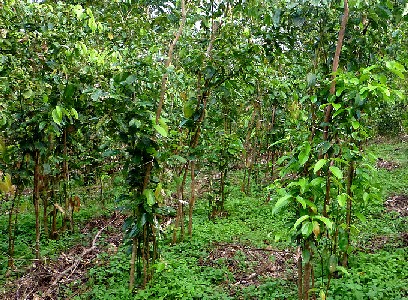
Photo: Ji-Elle - Cinnamomum Verum Trees (Sri Lanka)
Description: "Cinnamomum, or Cinnamon... warmeth, comforteth, concocteth, mollifieth [soothes], & wonderfully cheareth up the heart, & all the faculties of the body, as well Animall, as vitall and naturall. It is very good against the fluxes of the belly."5
"Cinamomi, Cinnamon. This, as was observ'd before under the Cassia Bark, was by the Antients confounded with that; but it is of a much more aromatick Flavour and Taste, and is rough upon the Palate, whereas the other is quite slimy. This is not only an admirable Astringent [contracts the body's tissues], and a great Strengthener of the Stomach and Bowels, but also a good Cephalick [medicine for treating problems of the head]. There are not kind of Defluxions [flows] or Weaknesses, but what it is of service in. It affords an Oil which will sink in Water, and is of great esteem, and much prescribed in extemporaneous Practice [from the Latin 'ex tempore' ("at the time") - a prescription written on the spot for a specific patient with a specific ailment]."6
"The Cinnamon-tree grows as commonly in the Island of Zeiland [probably Ceylon - modern Sri Lanka - known for its' cinnamon], in the Hedges and Woods, as the Hazel-tree doth in our Country; and the Inhabitants value it no more; for they commonly make Fires of it, and cut it for any common use."7
1 John Woodall, the surgions mate, 1617, p. 103; 2 "158. John Tweedy's Bill for Medicines. November 8, 1743". Privateering and Piracy in the Colonial Period Illustrative Documents, John Franklin Jameson, ed., p. 460; 2 Nicholas Culpeper, Pharmacopœia Londinesis, 1720, p. 14; 3 Jean de Renou, A Medicinal Dispensatory, 1657, p. 277; 4,5 Woodall, p. 103; 6 John Quincy, Pharmacopoeia Officinalis & Extemporanea, 1719, p. 101; 7 John Pechey, The Compleat Herbal of Physical Plants, 1707, p. 241
Cortex Granatorum (Pomegranate Rind)
Listed in: Woodall: Cortex Granatorum1
Category: Simple - Plant
Humoral Property: cools2; cools [refrigerative]3
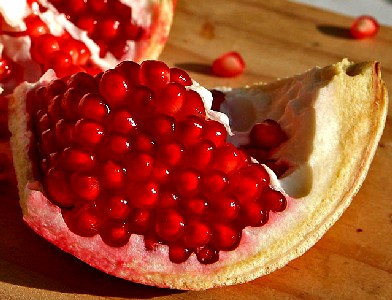
Photo: Wiki User Fir0002 - Pomegranate Seeds and Rind
Description: "Cortex Granatorum, seu Malicorium is astringent, stoppeth the laske [looseness of the bowels], and bloudy flixe [flux - diarrhea], healeth the gums moist, and weake, fasteneth the teeth loose, stoppeth the bleeding of greenewounds, an helpeth the corruption of the stomake, bowels, and the bursting or falling downe of the guts [likely referring to a rectal prolapse]."4
“[Cortices, Barks of] Granatorum, Pomegranates. This is reckon’d much more astringent than the Juice... It is therefore much order’d in Decoctions against Gonnorrhœa’s and Fluxes, and often in astringent [contracting the body's tissues] Clysters; tho its share in the Shop-Compositions [compound medicines made by apothecaries] is but little."5
"It grows in France, Italy and Spain."6
1 John Woodall, the surgions mate, 1617, p. 98; 2 Nicholas Culpeper, Pharmacopœia Londinesis, 1720, p. 15; 3 Jean de Renou, A Medicinal Dispensatory, 1657, p. 374; 4 Woodall, p. 98; 5 John Quincy, Pharmacopoeia Officinalis & Extemporanea, 1719, p. 102; 6 John Pechey, The Compleat Herbal of Physical Plants, 1707, p. 323
Cortex Guaiacum (Guaiacum Bark)
Listed in: Woodall: Cortex Guaiaci.1, Moyle: Lignum Guiacum2, Tweedy: Lign. Guejac.3
Category: Simple - Plant
Humoral Property: hot [calefying]4; "very hot and drying"5; dry [exiccate]6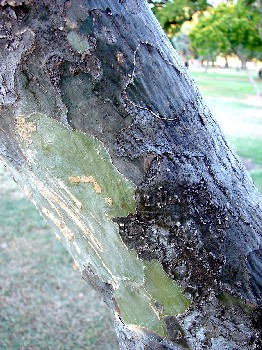
Photo: Forest & Kim Starr - Guaiacum Bark
Description: "Guaicum doth exiccate [dry], attenuate [reduce the force of], open, purge, move sweate, resisteth contagion, and infection, and doth wonderfully cure the morbius Gallicus [syphillis], olde ulcers, scabs, and ring-worme, the best use thereof is by decoction in faire water [clean, pure water]."7
"Guaiaci, Holy-wood, or Pock-wood; for it has many Names. This is the Wood of a Tree that grows very tall in the West-Indies: ...a great Promoter of insensible Perspiration rather than Sweat. Upon this account it is reckon'd a wonderful Sweetner and Cleanser of the Blood and therefore much prescrib'd in cutaneous Foulnesses, of all kinds. By the same hot penetrating Quality it is likewise esteem'd good in the Gout, by disspating and insensibly wasting the Humours thrown upon the Joints; as also in Dropsies [edemas] and Catarrhs [mucous build up], by drying up and wasting the superflurous Humdities. But in Veneral Cases it is said to do wonders; upon which account it has obtain'd its Name of Pock-wood."8
"Guaiacum grows in Hispaniola, Jamaica, and some other Places."9
1 John Woodall, the surgions mate, 1617, p. 98; 2 John Moyle, The Sea Chirurgeon, 1693, p. 33; 3"158. John Tweedy's Bill for Medicines. November 8, 1743". Privateering and Piracy in the Colonial Period Illustrative Documents, John Franklin Jameson, ed., p. 459; 4 Jean de Renou, A Medicinal Dispensatory, 1657, p. 288; 5 John Quincy, Pharmacopoeia Officinalis & Extemporanea, 1719, p. 103; 6 Woodall, p. 120; 7 Quincy, p. 103; 9 John Pechey, The Compleat Herbal of Physical Plants, 1707, p. 274
Crocus (Saffron)
Listed in: Woodall-Chest: Saffron1, Moyle: Indes.2, Tweedy: Croc. Orient.3
Category: Simple - Plant
Humoral Property: hot & dry in the second degree4; "hot in the second degree and drie in the first"5
Photo: Wiki User Alamout - Saffron Plants
Description: "Crocus or Saffron ...is good for the braine, quickeneth the senses, cheareth the heart, causeth digestion, helpeth the diseases of the brest, lungs, and liver, it mollifieth [softens] all hardnesses, and ripeneth all tumors."6
"Croci, Saffron. These blow [blossom] in September, and are a nice Culture, and a valuable commodity in some Parts of England, particularly in Essex and Cambridgeshire; and is the best of any in the World that we have met with. ...five or six Grains of English Saffron that is good, has very sensible Effects. ... It is certainly one of the greatest Cordials [good for the heart] of any Simple the whole Materia Medica supplies; and as effectually promotes a Diaphoresis [sweating - to force humors out of the body], which makes it hardly ever omitted in extemporaneous Prescriptions [from the Latin 'ex tempore'("at the time") - a prescription written on the spot for a specific patient with a specific ailment], for any species of Fevers. It wonderfully assists the Eruption of the Measles and Small-Pox... It is also given in almost all Disorders of the Lungs; and for its great efficacy in promoting Expectoration [removal of mucus from the lungs], and relieving the Breath, it is call'd by some Anima Pulmonum, the Soul of the Lungs."7
1 John Woodall, the surgions mate, 1617, p. 97; 2 John Moyle, The Sea Chirurgeon, 1693, p. 33; 3 "158. John Tweedy's Bill for Medicines. November 8, 1743". Privateering and Piracy in the Colonial Period Illustrative Documents, John Franklin Jameson, ed., p. 459; 4 Thomas Brugis, The Marrow of Physick, 1669, p. 158; 5 Nicholas Culpeper, Pharmacopœia Londinesis, 1720, p. 17; 5,6 Woodall, p. 120; 7 John Quincy, Pharmacopoeia Officinalis & Extemporanea, 1719, p. 164
Cubebæ
Listed in: Tweedy: Cubebs1
Category: Simple - Plant
Humoral Property: hot in the second degree, dry in the third2; hot3; hot [calefy]4
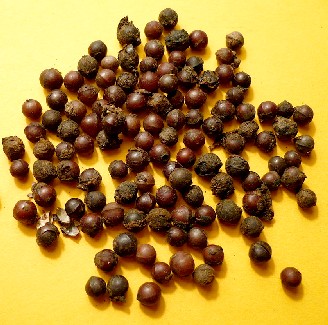
Photo: Wiki User Badagnani - Cubebs - Dried Ashanti Peppers
Description: "Cubebs, ...discuss [disperse], strengthen the viscera [internal organs], and chiefly the head."5
"Cubebæ, of Cubebs. they are small spicy Grains, or Berries, like Pepper, brought chiefly from Java in the East-Indies, and pretty much of the like Virtue: they are very warm, and are accounted to strengthen the Memory; which they cannot do, but by being very grateful to the Nerves. They are also reckon'd, as most such Aromaticks are, Provokers to Venery [sexual desire]; as they fill the Juices with many active, spiritious and titulating Particles."6
"Cubebs are like Pepper, and sometimes a little larger. They heat and dry. They strengthen the Stomach when it is oppress'd with Wind of phlegm. They purge the Breast, by carrying off clammy and gross Humours. They relieve the Spleen, and expel Wind, and cure Cold Diseases of the Womb. Being chew'd with Mastick often, they strengthen the Brain, and draw phlegm from the Head."7
1 "158. John Tweedy's Bill for Medicines. November 8, 1743". Privateering and Piracy in the Colonial Period Illustrative Documents, John Franklin Jameson, ed., p. 460; 2 Thomas Brugis, The Marrow of Physick, 1669, p. 159; 3 Nicholas Culpeper, Pharmacopœia Londinesis, 1720, p. 42; 4 Jean de Renou, A Medicinal Dispensatory, 1657, p. 282; 5 Brugis, p. 159; 6 John Quincy, Pharmacopoeia Officinalis & Extemporanea, 1719, p. 84; 7 John Pechey, The Compleat Herbal of Physical Plants, 1707, p. 255
Epithymi
Listed in: Moyle:Epithimum1
Category: Simple - Plant
Humoral Property: hot and dry in the third degree when it grows on thyme2
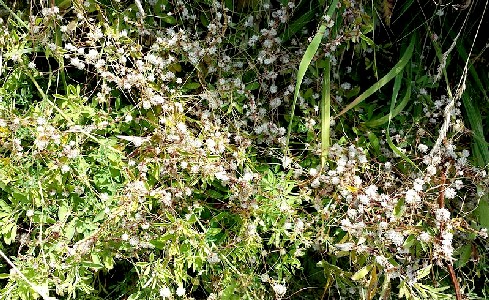
Photo: Stefan Lefnaer
Dodder (Cuscuta epithymum), A Parasitic Plant Which Grows on Other Plants (The White Flowers)
Description: "Epithymi, Dodder of Thyme. ...it often is met with in such Compositions [compound medicines] as are intended for cleaning the Blood, and cutting off a supply of such Humours as promote cutaneous Eruptions and Exulcerations, whereby the Cure of such Disorders is much assisted."3
"Epithimium Dodder of Time, to which add common Dodder, which is usually that which grows upon flax. Inde[e]d every Dodder retains a virtue of that Herb or Plant it grows upon, as Dodder that grows upon Broom, provokes Urine forcibly, and loosens the belly... that which grows upon Time... opens obstructions, helps infirmities of the Spleen, purgeth Melancholly [black bile - one of the bodily humors], relieves drooping Spirits, helps the Rickets."4
"[Dodder] having no Leaves, nor Root, when it is grown up; consisting only of long Threads, by which it encompasses the neighbouring Plants, and sucks away their nourishment. Upon which Account the Countrey-people of Suffex call it Hell-weed, or the Devil's Guts."5
1 John Moyle, The Sea Chirurgeon, 1693, p. 33; 2 Nicholas Culpeper, Pharmacopœia Londinesis, 1720, p. 26; 3 John Quincy, Pharmacopoeia Officinalis & Extemporanea, 1719, p. 122; 4 Culpeper, p. 26; 5 John Pechey, The Compleat Herbal of Physical Plants, 1707, p. 76
Euphorbium
Listed in: Woodall-Chest: Euphorbium1
Category: Simple - Plant
Humoral Property: "hot and drie almost in the fourth degree"2
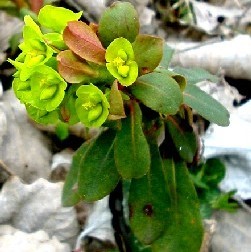
Euphorbia Wood Spurge
Description: "Euphorbium ...besides his extreame heate and notable acrimonie [acrimony - bitterness], it hath a certaine facultie of purging, whereby tough and cold phleame with choler [phlegm with choler - bodily humors], and water are taken away."3
"Euphorbii, Euphorbium. This is a Gum, or rather inspissated [thickened] Juice, of a pale yellow Colour, and concreted into Drops of different shapes. [Flemish physican Rembert] Dodonæus says it is gotten from a Plant; but [Pedanus] Dioscorides, that it comes from a Tree. ...the more curious among the Moderns have found it to proceed from a thick-leaved African Spurge. It is so extremely hot and penetrating, as to prove even Caustick [corrosive]: wherefore, altho it is mention'd as a Purge in many Authors, against serous and viscous Humours, and its Dose assign'd from half a Scruple to a whole one; yet it is now never given inwardly, because its Violence tears off the necessary Mucus, or Covering of the Stomach and Bowels, and occasions Dysenteries. As a Sternutatory [medicine to cause sneezing], it is to be used very cautiously, and never taken alone; but mixed in a small quantity with some other Powder, proper to soften the Fibres, and guard them against the intolerable Heat of the Euphorbium. In pounding it [with a mortar and pestle] there may be much danger; because without great care so much will fly up the Nostrils, as to do mischief. This is of good use in Chirurgery, in cleansing very foul Ulcers, and exfoliating of carious [rotting] Bones."4
1,2,3 John Woodall, the surgions mate, 1617, p. 95; 4 John Quincy, Pharmacopoeia Officinalis & Extemporanea, 1719, p. 196
Farina Fabarum (Bean Meal)
Listed in: Woodall: Farina fabarum1, Moyle: Farina Fabarum2
Category: Simple - Plant
Humoral Property: cold and dry in the first degree3; "cold and moist"4
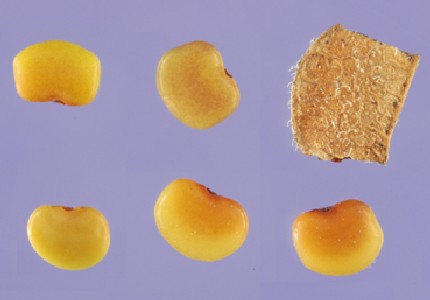
Photo: USDA - Legumes for Making Bean Meal (Desmodium Triflorum)
Description: "Farina fabarum or Beane meale... dissolveth all swellings, is very good for ulcers, evills [possibly referring to the king's evil or tuberculosis], and blastings of the genitories [probably referring to pain in the genitals], and taketh away inflammations of womens paps [nipples]."5
"One and a half ounce of bean flour. Makes emplastrum. Doctors often use this to remedy dropsy [edema], the most celebrated of which are [Italian physicians] John Baptist Montanus and Aloysius Bellacatus."6
"Fabæ, Beans. ...[These are] too well known in our own Country to need any Description… They are all very nourishing in Food. And tho the particular Management of some of them in Diet, may give them a place rather amongst Detergents... In Medicine they are little used, unless in some particular Intentions they are prescrib’d in Cataplasms [poultices], and outward Applications."7
1 John Woodall, the surgions mate, 1617, p. 118; 2 John Moyle, The Sea Chirurgeon, 1693, p. 33; 3 John Pechey, The Compleat Herbal of Physical Plants, 1707, p. 18; 4,5 Woodall, p. 118; 6 Johann Zwelfer, Pharmacopoeia Augustana Reformata Et Eivs Mantissa, (Translated from Latin by the author), 1653, p. 661; 7 John Quincy, Pharmacopoeia Officinalis & Extemporanea, 1719, p. 97
Farina Hordei (Barley Meal)
Listed in: Woodall: Farina hordei1
Category: Simple - Plant

Humoral Property: cools [refrigerates] and dries [exsiccates]2; "cold and drie in the first degree"3
Description: "Farina hordeacea or Barly meale ...dissolveth hot and colde tumours, digesteth [breaks down], softneth, and ripeth hard swellings, stoppeth the laske [looseness of the bowels], and humors falling into the joints, discusseth [disperse] winde is good against the scurfe [flaking of the skin] and leprosie, and allaieth [allays] the inflammations of the Goutes."4
“Hordeum, Offic. Hordeum distichum... It is sow'd in the Spring in the Fields. The Seed is used which is refrigerating [cooling], drying, abstergent [deteregent/cleansing], aperient [laxative], digestive [promotes healthy flesh formation], and emollient [softening]; it is also diuretic and nutritive."5
1 John Woodall, the surgions mate, 1617, p. 118; 2 Jean de Renou, A Medicinal Dispensatory, 1657, p. 366; 3,4 Woodall, p. 118; 5 Robert James, Pharmacopoeia Universalis, 1747, p. 270
Farina Tritici (Wheat Meal)
Listed in: Woodall: Farina tritici1
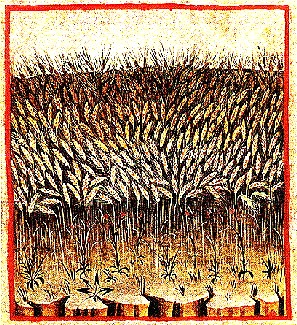
Wheat - Tacuin Blé14.jpg (14th century)
Category: Simple - Plant
Humoral Property: hot and moist in the second degree2; "hot in the first degree"3
Description: "Farina tritici Wheate flower ...stoppeth spitting of bloud, distillations of subtill humours, helpeth the cough, roughnesses of the sharpe arterie, dissolveth tumours, and clenseth the face from lentills and spots, appeaseth hunger and thirst, and is the principall naturall upholder of the life and health of man."4
“Triticum ...Wheat. This is the common Food of almost all Europe. The Meal applied externally by way of Cataplsam, is used for mollifying (softening) and relaxing Tumours, for Inflammations and Fluxions of the Eyes; and the dry'd Meal is applied to an Erysipelas [Also called St. Anthony Fire, an acute inflammation of the skin], and is used to ease the Pains of the Gout."4
1 John Woodall, the surgions mate, 1617, p. 117; 2 Theatrum of Canatese, Tacuinum sanitatis - Casanatense 418 on wikimedia commons, gathered 6/1/15; 3 Woodall, p. 117; 4 Woodall, p. 117-8; 4 John Quincy, Pharmacopoeia Officinalis & Extemporanea, 1719, p. 216
Farina Volatilis (Mill Dust)
Listed in: Woodall: Farina Volatilis1
Category: Simple - Plant

Washburn Flour Mill Explosion (1878)
Humoral Property: "knowen colde and drye"2
Description: “fine floury dust thrown out by a grain mill, mill dust… Farina volatilis, mylne duste"3
Farina Volatilis literally means 'volatile dust'. The presence of large amount of fine dust particles suspended in the air in an enclosed space such as a mill could explode violently when a source for ignition was provided, thus the term 'volatile'.
"Farina Volatilis or Mill dust is used in compositions [compound medicines] to staye fluxes of bleeding wounds."4
1 John Woodall, the surgions mate, 1617, p. 118; 2,3 "Dust", Middle-English Dictionary Entry, umich.edu, gathered 2/25/15; 4 Woodall, p. 118
Flores Anthos (Rosemary Flowers)
Listed in: Woodall: Flores Anthos1
Category: Simple - Plant
Humoral Property: hot and dry in the second degree2; hot [calefactive]3; "hot and drie in the second degree"4
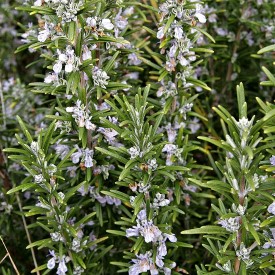
Rosemary Flowers
Description: "Flores Anthos, or Rosemary flowers,...comfort the braine, heart and memorie, and oher senses, amend the speech, helpe digestion, mollifie [soften], cleanse, and cut away fleame [phlegm - one of the bodily humors].”5
“Rosemary. It grows in Gardens, and flowers in Spring. The Leaves, Flowers and Seed are used, which are greatly cephalic [useful in problems of the head], nervine [useful in nerve problems] and uterine; they are of great Service in Disorders of the Head, Nerves, and Uterus, Apoplexies [unconsciousness], Epilepsies, Palseys, Vortigoes [vertigo], and a Carus [insensibility and sleepiness]. They sharpen the Sight, cure a fetid Breath, resolve all Obstructions of the Liver, Spleen, and Uterus; they cure the Jaundice, and Fluor Albus [discharge from the vagina] in Women, and greatly comfort the Heart.…
Of Rosemary Flowers gathered in the Middle of the Day bruised with Sugar, and afterwards preserved from the Air in a Galley Pot [gallipot], is made the celebrated English Conserve [jelly], called in the Shops Conserva Florum Anthos, which is an excellent Remedy in Vertigoes arising from a cold Cause, as also in cold Distempers, in Consequence whereof it is an excellent Stomachic [medicine for treating stomach problems], and proper in that Disorder of the Eyes called Lema Lippea, when not Proceeding from an Inflammation."6
1 John Woodall, the surgions mate, 1617, p. 115; 2 Thomas Brugis, The Marrow of Physick, 1669, p. 205; 3 Jean de Renou, A Medicinal Dispensatory, 1657, p. 340; 4,5 Woodall, p. 115; 6 Robert James, Pharmacopoeia Universalis, 1747, pp. 421-2
Flores Balaustiorum (Pomegranate Flowers)
Listed in: Woodall: Flores Balaustiarum1
Category: Simple - Plant
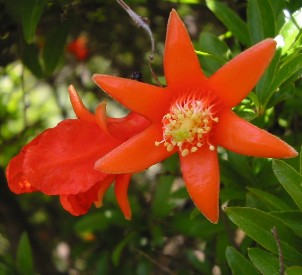
Photo: Wiki User Bouba - Pomegranate Flower
Humoral Property: cool2; cool [refrigerative]3; "cold and drie in the third degree"4
Description: "Flores Baluaustarium or flowers of pomegranats are ...astringent [contract tissue]: close up, and stoppe, they cure the bloudy flixe [bloody flux or diarrhea], bleeding of greene wounds, they are good in lotiens for moist and weake gummes, kill wormes, and fasten loose teeth."5
“Pomegranate, in Latin Malus Punica sive Granata. It grows in France, Italy and Spain. … The Flowers are very astringent, wherefore they are frequently used for Fluxes of all kinds. The powder of them being sprinkled on Ulcers, soon Cicatrizes [heals] them, and cures Ulcers of the Mouth."6
1 John Woodall, the surgions mate, 1617, p. 115; 2 Thomas Brugis, The Marrow of Physick, 1669, p. 156; 3 Jean de Renou, A Medicinal Dispensatory, 1657, p. 374; 4 Woodall, p. 115; 5 Woodall, p. 115-6; 6 John Pechey, The Compleat Herbal of Physical Plants, 1707, p. 322
Flores Borago (Borage Flowers)
Listed in: Moyle: 4 Cordial Flowers - Borage1
Category: Simple - Plant
Humoral Property: hot and moist2
Photo: Wikii User Patafisik - Borrago Officinalis Flowers
Description: "Borage and Bugloss Flowers strengthen the Brain, and are profitable in Fevers."3
"Borrage, in Latin Borrago. 'Tis very cordial [good for the heart]; and the Flower is one of the four Cordial-Flowers. The distill'd Water, and the Conserve of the Flowers, comfort the Heart, relieve the Faint, chear the Melancholy, and purifie the Blood."4
"It grows in any ground, but it is more florid in humid and fat soyl. It is fresh all Summer, and also all Autumn, if it be sown later... Its flowers put into a broth give a special taste, and subduce the belly; and taken in Wine, they cause great joy and pleasure; according to that old saying, Ego Borrago guadia semper ago ['I always thank the joys of Borrago'. -16th century herbalist John Gerard.] Its flowers in Condiments recreate the eyes and jaws, and in Medicaments augment their cordial faculties."5
1 John Moyle, The Sea Chirurgeon, 1693, p. 35; 2 Jean de Renou, A Medicinal Dispensatory, 1657, p. 228; 3 Nicholas Culpeper, Pharmacopœia Londinesis, 1720, p. 40; 4 John Pechey, The Compleat Herbal of Physical Plants, 1707, p. 24; 3 Jean de Renou, A Medicinal Dispensatory, 1657, pp. 228-9
Flores Bugloss (Bugloss Flowers)
Listed in: Moyle: Cordial Flowers - Bugloss1
Category: Simple - Plant
Humoral Property: hot and moist2
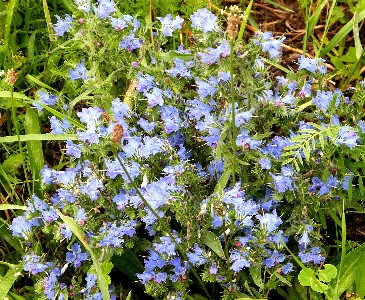
Photo: Gail Hampshire - Bugloss Flowers
Description: "Borage and Bugloss Flowers strengthen the Brain, and are profitable in Fevers."3
"[Bugloss] corrects burnt choler [choler or yellow bile, one of the bodily humors, that has been altered by being overheated and is now harmful to the proper functioning of the body], antihypocondriac [referring here not to imagined illnesses, but to to the upper abdomen and the organs under the ribs (liver, gall bladder, spleen) which were believed to be the source of melancholy and black bile]."4
"Bugloss [is]... alwayes green; for it resembles both their form and nature and is thought to propoll in the same faculties [as Borrage]. It grows in Plains, and is sown and kept in Gardens by such as delight in variety of Simples."5
1 John Moyle, The Sea Chirurgeon, 1693, p. 35; 2 Jean de Renou, A Medicinal Dispensatory, 1657, p. 228; 3 Nicholas Culpeper, Pharmacopœia Londinesis, 1720, p. 40; 4 Thomas Brugis, The Marrow of Physick, 1669, p. 147; 5 Jean de Renou, A Medicinal Dispensatory, 1657, p. 229
Flores Centaurium (Centaury Flowers)
Listed in: Woodall: Flores Centaury1
Category: Simple - Plant

Photo: Evelyn Simak- Lesser Centaury
Humoral Property: hot and dry in the 1st degree2; heats [calefies] potently3; "of a hot and drie complexion in the second degree"4
Description: "Flores centaury or flowers of centrey ...purge choler [yellow bile - a bodily humor], and grosse humours downeward, open the obstructions of the liver, kill wormes, cause the course of flowers [menstruation], are good against the Jaundice, hardnes of the spleene, griefes of the sinewes, cleare the eyes, heale wounds, and drive forth young fruite."5
“Centaurium Minus, Offic... It flowers in June and July; and is of a very bitter Taste, and of an aperitive [opening] cleansing Faculty, open Obstructions of the Liver and Spleen, provokes Urine and the Menses, alleviates the Jaundice and intermitting Fevers, strengthens the Stomach, and destroys Worms; outwardly it is used in Fomentations against Swellings and Inflammations. It is an Ingredient in the Theriaca Andromachi."6
1 John Woodall, the surgions mate, 1617, p. 116; 2 Thomas Brugis, The Marrow of Physick, 1669, p. 148; 3 Jean de Renou, A Medicinal Dispensatory, 1657, p. 335; 4 Woodall, p. 116; 5 Woodall, p. 116-7; 6 Robert James, Pharmacopoeia Universalis, 1747, p. 284
Flores Chamæmeli
Listed in: Woodall: Flores chamomillæ1, Moyle: Flores Camæmeli2, Tweedy: Flor. Chamomel3
Category: Simple - Plant
Humoral Property: hot and dry in the first degree4; hot & dry in the first degree5; "hot & drie in the first degree"6

Photo: Erin Silversmith - Chamomile Flowers
Description: "Flores chamomillæ Camomile flowers ...provoke the monthly termes [menstruation], and urine, are good against windinesse, and chollicke [cholic], gravell, [the kidney] stone, aches, fevers proceeding from obstructions, cure wearied parts, also they open, loose, mollifie [soften] the hard swollen and stopt parts of the intrells [entrails]."7
“Chamamelum; Sativum, Sylvester, Garden and white Chamomel. Garden Chamomel, is ...as gallant a Medicine against the Stone in the Bladder as grows upon the earth: you may take it inwardly. I mean the Decoction of it, being boiled in white Wine, or inject the juyce of it into the Bladder with a Syringe. It expels wind, helping belching, & potently provokes the Terms. Used in baths it helps pains in the sides, gripings and gnawing in the belly."8
“Chamæmeli, Camomile. It flowers in July. With the Carminative Virtues of the former, this is also accounted a good Anodyne [pain-killer], and excellent against Cramps, and such-like Spasms. Outwardly, it is a good Emolient [softener of the skin] and Ripener, in Cataplasms. It is used with success likewise against the Tooth-Ach, apply’d hot, in a Bag, to the Cheek."9
1 John Woodall, the surgions mate, 1617, p. 116; 2 John Moyle, The Sea Chirurgeon, 1693, p. 35; 3 "158. John Tweedy's Bill for Medicines. November 8, 1743". Privateering and Piracy in the Colonial Period Illustrative Documents, John Franklin Jameson, ed., p. 459; 4 Thomas Brugis, The Marrow of Physick, 1669, p. 148; 5 Nicholas Culpeper, Pharmacopœia Londinesis, 1720, p. 24; 6,7 Woodall, p. 116; 8 Culpeper, p. 24; 9 John Quincy, Pharmacopoeia Officinalis & Extemporanea, 1719, p. 88
Flores Crocus Sativus (Saffron Flowers)
Listed in: Moyle: Flores Croci Angliæ1
Category: Simple - Plant
Humoral Property: hot and dry in the 2nd degree2
Photo: Wiki User Alamout - Saffron Plants
Description: "Saffron, ...good for the brain, quickneth the senses, cheareth the heart, causeth digestion [rebuilding new skin], helpeth the diseases of the breast, lungs, and liver; it mollifieth [softens] all hardness, and ripeneth all tumors, 'tis call'd anima pulmonum: 'tis uterine, 2 or 3 drops of the tincture given in Fits, in asthma, with ol. amygdal [oil of almonds] Dose to {1 scruple}."3
"Saffron, in Latin Crocus. The moderate use of it is good for the Brain. It renders the Senses brisk: It shakes off Sleep and Dulness, and chears and strengthens the Heart. It concocts the Crude Humours of the Breast, and opens the Lungs, and frees them from Obstructions. And it is such an effectual Remedy for the Breast and Lungs, that it sometimes revives Consumptive People [people with tuberculosis], when they are, in a manner, worn out. 'Tis frequently used in Faintings, for Apoplexies [unconsciousness], in the jaundice, and for Obstructions of the Liver, in the Plague, and other Malignant Diseases. 'Tis also good in an Asthma, mix'd with Oyl of Almonds. It provokes Urine, and the Courses [menstruation], and hastens Delivery. Half a Scruple, or a Scruple at most, infus'd in Canary-wine, is very effectual in the Jaundice. 'Tis much used to drive out the Small-Pox; but, undoubtedly, it does many time much hurt, by inflaming the Blood, and occasioning Frensies, and making them Flux."4
"These blow [blossom] in September, and are a nice Culture, and a valuable commodity in some Parts of England, particularly in Essex and Cambridgeshire; and is the best of any in the World that we have met with."5
1 John Moyle, The Sea Chirurgeon, 1693, p. 35; 2,3 Thomas Brugis, The Marrow of Physick, 1669, p. 158; 4 John Pechey, The Compleat Herbal of Physical Plants, 1707, p. 206-7; 5 John Quincy, Pharmacopoeia Officinalis & Extemporanea, 1719, p. 164
Flores Hyperici (Flowers of St. John's Wort)
Listed in: Woodall:Flores Hyperici1
Category: Simple - Plant
Humoral Property: hot and dry2; hot [califies] & dry [siccates]3; "hotte and drie in the third degree"4
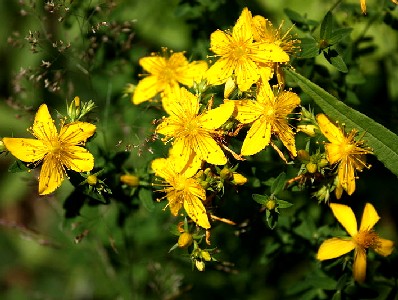
Photo: Leslie Seaton - Flowers of St. John's Wort
Description: "Flores Hyperici or flowers of Saint Johns wort ...breake the [kidney] stone, provoke urine, bring downe womens flowers [cause menstruation to begin], stoppe the laske [looseness of the bowels], drive away fevers, are good for burnings, and cure olde, and fistulated sores."5
“Hypericum, Offic. ...St. John’s Wort. This grows in Hedges and Thickets, and flowers in July. The Herb, Flowers and Seeds are used; they consist of subtile Parts, are Diuretic and Vulnerary [heal wounds]. They are chiefly used in cleansing and consolidating Wounds, in resolving [removing] coagulated Blood, in dissolveing the Stone in the Kidneys, and killing Worms. Outwardly applied it is reckon’d good in Contusions, especially those of the Nerves, and also in Tremors and Wounds. The Tincture of the Flowers is good in Maniac Disorders."6
Modern Uses: St. John's wort appears to be an effective antidepressive. There is no evidence to support the effects reported by period authors. Note that this is not medical advice and the author is not a medical professional. St. Johns wort can weaken the effectiveness of many medicines including antidepressants, birth control pills, cyclosporine, heart medications, HIV drugs, cancer medications, warfarin and some statins.
1 John Woodall, the surgions mate, 1617, p. 117; 2 Thomas Brugis, The Marrow of Physick, 1669, p. 150; 3 Jean de Renou, A Medicinal Dispensatory, 1657, p. 328; 4,5 Woodall, p. 117; 6 Robert James, Pharmacopoeia Universalis, 1747, p. 343
Flores Meliloti (Melilote Flowers)
Listed in: Woodall: Flores meliloti1
Category: Simple - Plant
Humoral Property: hot in the first degree2; indifferent as to either cold [refrigeration] or hot [calefaction]3; "of a drie and hot qualitie"4
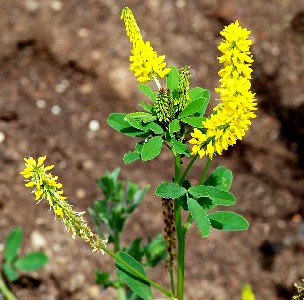
Photo: Wiki User Alvesgaspar - Flowers of Melilotus Offininalis
Description: "Flores melliloti flowers of Mellilote ...digest [break down], consume, dissolve, and maturate, prevaile against all hot swellings, provoke urine, breake the [kidney] stone, asswage the paine of the kidnies, bladder, and belly, ripen fleame [phlegm - one of the bodily humors], and cleare the eie-sight."5
“Melilotus, Offic. ... It grows in Hedges and among Corn, flowering in July. Melilot takes it Name from Honey and a celebrated Plant among the Antients [ancient physicians], not from its sweet Taste, for the Leaves, Flowers, and Fruit are bitter, but because there is no Plant from which the Bees gather sweeter Honey, or more in Quantity. The Leaves, besides their emollient [softening] Quality, are endued with a Virtue of healing in a very gentle manner, by their aromatic Quality; the Flowers, are also aromatic and emollient, and therefore, reckoned among internall Pectorals [useful for treating problems with the respiratory tract]; but they are more used outwardly, as emollient, discutient [matter dispersing], and anodyne [treating pain], on which Accounts they are serviceable in all Sorts of Inflammations, particularly of the Uterus, Testes, and Anus, as well as in nephritic [kidney-based inflammation], and Arthritic Pains."6
1 John Woodall, the surgions mate, 1617, p. 116; 2 Thomas Brugis, The Marrow of Physick, 1669, p. 156; 3 Jean de Renou, A Medicinal Dispensatory, 1657, p. 364; 4,5 Woodall, p. 116; 6 Robert James, Pharmacopoeia Universalis, 1747, p. 369;
Flores Rosarum Rubrarum (Red Roses)
Listed in: Woodall: Rosa Rubeæ1, Moyle: 4 Cordial Flowers - Roses2, Tweedy: Flor. Rosar. Rubr.3
Category: Simple - Plant
Humoral Property: cold in the second degree, dry in the third4; cold in the first degree, dry in the third (others in the second)5; "cold and drie in the first degree"6
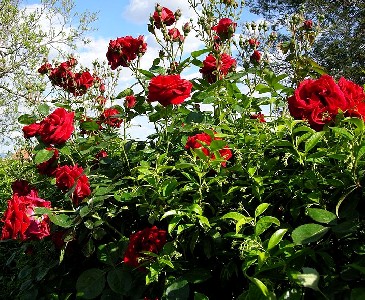
Photo: Yellow Cat - Red Roses
Description: "Rosa rubeæ or Red-roses ...refrigerate [cool], and are astringent [cleansing], they purge chollericke humors [yellow bile - a bodily humor] downward, open, strengthen, and clense the liver from obstructions, comfort the head, stomacke, and heart, helpe against consumptions [tuberculosis], and inflammations, cause sleepe, and stop spitting of bloud."7
“The Rose, in Latin Rosa. …The Red Rose is astringent, and bitter: It comforts the Heart, and strengthens the stomach. It cures the Whites [discharge from the vagina], and an immoderate Flux of the Courses [menstruation]. It stops Eruptions of the Blood, and Fluxes of the Belly. A Decoction of it is used for the Head-ach, and Pains in the Eyes, Ears, Throat and Gums. The distill’d Water of it is Cordial [good for the heart], and refreshes the Spirits."8
1 John Woodall, the surgions mate, 1617, p. 116; 2 John Moyle, The Sea Chirurgeon, 1693, p. 35; 3 "158. John Tweedy's Bill for Medicines. November 8, 1743". Privateering and Piracy in the Colonial Period Illustrative Documents, John Franklin Jameson, ed., p. 459; 4 "Tacuin Roseter34.jpg", Roses From the Theatrum of Casanatense, wikimedia commons, gathered 6/1/15; 5 "File:Tacuin Rosebis33.jpg", Roses From the Tacuinum of Vienna, wikimedia commons, gathered 6/1/15; 6,7 Woodall, p. 116; 8 John Pechey, The Compleat Herbal of Physical Plants, 1707, p. 203
Flores Sambuci (Elder Flowers)
Listed in: Woodall: Flores Sambuci1
Category: Simple - Plant
Humoral Property: "hot and drie in the third degree"2
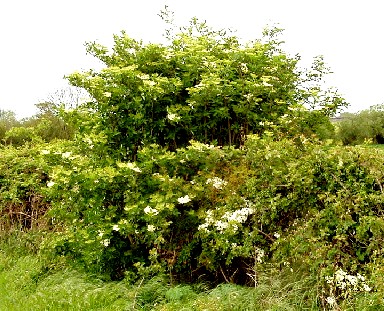
Photo: David Hawgood - Elder Flowers (White) Growing in a Hedge
Description: "Flores Sambuci or flowers of Elders ...open the belly, purge slimie fleame [phlegm - one of the bodily humors], and chollericke [yellow bile] humours, and are good for hot swellings, and tumours, and for the asswaging the paine of the gout."3
“Sambucus, Offic. Sambucus vulgaris, J.B. Common Elder. It grows in Hedges, flowering in May. …The Flowers and Rob of Elder are highly and justly esteemed by the common People; for the former are with great Success externally applied for alleviating all Erysipelaceous Swellings [Eyrispelas or St. Anthony's Fire is an acute skin infection], Tooth-achs and Gouts; as also for softening Abscesses and hard Tumors, produced by coagulated Milk. The Water of these Flowers in consequence of its Anodyne [pain relieving] Quality, is of singular Efficacy in all Diseases, whether acute or chronical; but especially in those Disorders where Expulsion is proper, where the Pain is intense, and where there is an Inflammation of the internal parts."4
1,2,3 John Woodall, the surgions mate, 1617, p. 117; 4 Robert James, Pharmacopoeia Universalis, 1747, p. 429
Flores Viola (Violet Flowers)
Listed in: Moyle: 4 Cordial Flowers - Violets1
Category: Simple - Plant
Humoral Property: cold in the first degree and moist in the second2
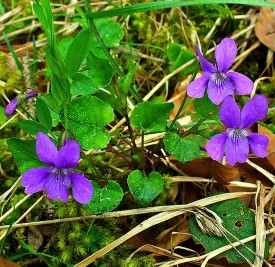
Photo: H. Zell - Violet Flowers
Description: "Violets ..dry'd they are weaker, they mollifie [soften], loosen, expectorate [cause coughing up of phlegm from the lungs], used chiefly in mitigating black choler [probably black bile - one of the bodily humors], allaying heat in feavers, in coughs, roughness of the throat, sharp catarrhs [mucus build up], pleurisie [plurisy, inflammation of the membrane around the lungs], &c."3
"Violarum, Violets. These blow [blossom] early in the Spring, and are in every one's acquaintence, for their Use in Medicine. The Syrup which is made of them is the only Preparation in the Shops, but is not by much so often prescribed as formerly; altho amongst the Nurses, it still remains in its wonted esteem, for a safe and gentle Purger of young Children. It's Dose is from a quarter of an Ounce to one Ounce. It's never given to grown Persons, as no Dose is sufficient to make it a proper Purge to them."4
1 John Moyle, The Sea Chirurgeon, 1693, p. 35; 2,3 Thomas Brugis, The Marrow of Physick, 1669, p. 181
Folia Senæ (Senna Leaves)
Listed in: Woodall: Folia Sene1, Moyle: Senna2, Tweedy: Senna.3
Category: Simple - Plant
Humoral Property: hot in the first degree, dry in the second4; "hot and drie in nature"5
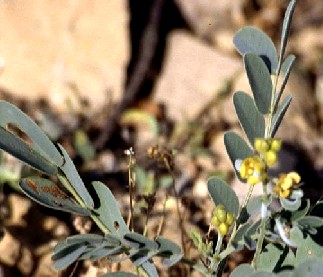
Photo: Wiki User Zeigler175 - Senna Leaves
Description: "Folia sene ...are an excellent medicament purging the belly; it scoureth away phlegmaticke, tough, and melancholy humors [phlegm and black bile - bodily humors], from the braine, lungs, spleene, liver, stomacke, and bowels, as also clenseth the body from adust [melancholly] and salt humors [note - this is a reference to Paracelsus' idea that the body contained three primary principles: sulphur, mercury and salt. Woodall is (incorrectly) calling salt a bodily humor, although he was certainly not alone in doing so at this time.]"6
"Senæ, Sena. The best comes from Alexandria [Egypt], is the sharpest-leaved of any sorts, and smells fresh if it be not old. The Brightness of its Colour, and Quickness of its Flavour, are the Indications of its Goodness; for when it has lost its Scent, and grows dusky, it is good for little. It is one of the most common Purgers in the Shops, and in extemporaneous Prescriptions [from the Latin 'ex tempore'("at the time") - a prescription written on the spot for a specific patient with a specific ailment]. Altho it is here placed amongst the milder sort [or purging medicines], yet in some Circumstances, and especially in an increased Dose, it will worm [remove intestinal worms] smartly enough. Its Dose in Powder is from half a Scruple to half a Dram, but it is seldom given in that manner by it self"7.
"It grows in Syria, Persia and Arabia; and from thence is carried into Egypt, and to Alexandria; from whence it is brought to us."8
1 John Woodall, the surgions mate, 1617, p. 93; 2 John Moyle, The Sea Chirurgeon, 1693, p. 33; 3 "158. John Tweedy's Bill for Medicines. November 8, 1743". Privateering and Piracy in the Colonial Period Illustrative Documents, John Franklin Jameson, ed., p. 460; 3 Jean de Renou, A Medicinal Dispensatory, 1657, p. 257; 5,6 Woodall, p. 93; 7 John Quincy, Pharmacopoeia Officinalis & Extemporanea, 1719, p. 180; 8 John Pechey, The Compleat Herbal of Physical Plants, 1707, p. 332

